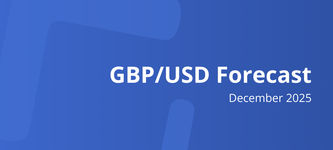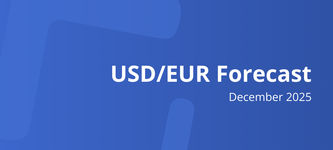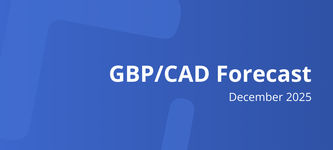USD to CAD Forecast - December 2025
If you're planning to send US dollars (USD) to Canada or Canadian dollars (CAD) abroad in December, here’s a straightforward update to help you make informed decisions.
This forecast focuses on the USD/CAD exchange rate, which is how much 1 US dollar buys in Canadian dollars.
Currently, the US dollar is relatively weak while the Canadian dollar is showing strength. It is currently trading at 1.37795 CAD per USD.
This trend has been in place for several months and is likely to continue into December, though some fluctuations may occur.
Search Now & Save On Your Transfer
What is likely to happen to USD/CAD in December 2025
USD to CAD is stuck near a critical support zone. Canada’s strong data and expectations of a US rate cut lean the pair slightly lower, but a bounce is still possible. Watch the 1.4000 level closely.
USD to CAD: Where It Stands
USD to CAD has spent the past several weeks hovering around the important 1.4000 level. This is a “make or break” zone because the market keeps bouncing off it.
When USD to CAD stays above 1.4000, the trend usually leans upward. When it dips below, the pair often sees deeper declines.
Right now, the market looks mixed, caught between strong Canadian data and expectations of a US interest rate cut.
What’s Driving USD to CAD?
The two biggest drivers are interest rate expectations and commodity prices.
Markets expect the US Federal Reserve to cut rates soon, which normally weakens the US Dollar.
Meanwhile, the Bank of Canada is likely to pause rate cuts due to stronger Canadian jobs and GDP data.
This supports the Canadian Dollar.
Oil prices are steady, which is helpful for Canada’s commodity focused economy.
Canada’s data looks firmer than US data, giving the Canadian Dollar a mild advantage. However, any improvement in US numbers could lend fresh strength to the USD.
What Do the Charts Say?
The pair has strong support around 1.3970 to 1.4010. If USD to CAD holds this area, it can rise again. Strong resistance sits at 1.4150 to 1.4180. A clear break above that zone could open the door to 1.4270 or even 1.4300. If the pair falls below 1.3930, the next major downside targets could be 1.3880, then 1.3720 and possibly 1.3600. Current chart signals show the pair sitting right on key support, where it could bounce, but bearish momentum has grown thanks to softer US data.
What to Watch in December 2025
The next month will focus on three things:
US jobs and inflation data, because they will influence whether the Federal Reserve cuts rates.
Canadian employment numbers, which will show if recent strength is lasting.
Oil prices, since they are tied to Canada’s economic performance.
If US data continues weakening, USD to CAD could fall below support. But if US numbers improve or Canada shows a meaningful slowdown, USD to CAD may push back toward the 1.4100 to 1.4200 region.
Risks Ahead
This outlines what could change the outlook.
Surprise Fed decisions could sharply move the US Dollar.
A sudden drop in oil prices would likely weaken the Canadian Dollar.
Sharp swings in risk sentiment globally can push USD to CAD in either direction.
Unexpectedly strong or weak Canadian jobs data could create quick moves.
What This Means If You’re Sending USD to CAD Abroad
If you are sending USD to Canada, rates above 1.40 mean your dollars go further. If the pair drops below 1.39, you will receive fewer Canadian dollars for each US dollar. With the market sitting at important support, there is a reasonable chance of short term bounces, but weaker US data could push the rate lower. If you need to send money soon, watching the 1.4000 level is key. Above it is generally more favorable for USD senders.
Live USD to CAD exchange rates
Converting USD to CAD
If you are planning to send USD to Canada, you need to pick the right money transfer company to get the most CAD on the other end.
Depending on your needs, it's best to use one of the following companies in December:




History of the USD to CAD
USD to CAD, also known as the loonie, is a popular forex pair because of the strong business relationship between the two countries.
They both are parts of the United States, Mexico, and Canada Agreement (USMCA), which replaced NAFTA in 2020. As a result, the two countries do goods trade every year.
The exchange rate is mostly affected by three main factors. First, the actions of the Federal Reserve and BoC. Historically, because of the role of the USD as the global currency reserve, the Fed has more weight compared to the BoC.
Second, the pair is also often impacted by the prices of crude oil. The US is the biggest oil producer while Canada is the fourth. However, in terms of exports, Canada exports most of its oil to the US. Therefore, higher oil prices have often resulted in a stronger Canadian dollar.
| Date | 1 US Dollar in CAD |
|---|---|
| Dec 04, 2025 | 1.396045 CAD |
| Dec 05, 2025 | 1.382750 CAD |
| Dec 06, 2025 | 1.382650 CAD |
| Dec 07, 2025 | 1.383540 CAD |
| Dec 08, 2025 | 1.385150 CAD |
| Dec 09, 2025 | 1.384630 CAD |
| Dec 10, 2025 | 1.379010 CAD |
| Dec 11, 2025 | 1.377655 CAD |
| Dec 12, 2025 | 1.378050 CAD |
| Dec 13, 2025 | 1.377950 CAD |

Our handy, modern currency app lets you:
Instantly convert 25,000+ currency pairs
Compare live transfer deals
Get reviews & insights
Our app is free for mobiles and tablets, with no intrusive ads or in-app purchases.
Related Content



Contributors






